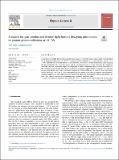A search for pair production of new light bosons decaying into muons in proton-proton collisions at 13 TeV
Author(s)
CMS Collaboration; Benvenuti, A. C.; Chatterjee, R.M.; Evans, A.; Hansen, P.; Hiltbrand, J.; Jain, Sh.; Kalafut, S.; Krohn, M.; Kubota, Yasuo; Lesko, Z.; Mans, J.; Ruckstuhl, N.; Rusack, R.; Wadud, M.A.; ... Show more Show less
DownloadPublished version (1.195Mb)
Publisher with Creative Commons License
Publisher with Creative Commons License
Creative Commons Attribution
Terms of use
Metadata
Show full item recordAbstract
A search for new light bosons decaying into muon pairs is presented using a data sample corresponding to an integrated luminosity of 35.9fb−1 of proton-proton collisions at a center-of-mass energy s=13TeV, collected with the CMS detector at the CERN LHC. The search is model independent, only requiring the pair production of a new light boson and its subsequent decay to a pair of muons. No significant deviation from the predicted background is observed. A model independent limit is set on the product of the production cross section times branching fraction to dimuons squared times acceptance as a function of new light boson mass. This limit varies between 0.15 and 0.39 fb over a range of new light boson masses from 0.25 to 8.5 GeV. It is then interpreted in the context of the next-to-minimal supersymmetric standard model and a dark supersymmetry model that allows for nonnegligible light boson lifetimes. In both cases, there is significant improvement over previously published limits. ©2019
Date issued
2019-09Department
Massachusetts Institute of Technology. Department of PhysicsJournal
Physics Letters B
Publisher
Elsevier BV
Citation
CMS Collaboration (Sirunyan, A.M., et al.), "A search for pair production of new light bosons decaying into muons in proton-proton collisions at 13 TeV." Physics Letters B 796 (Sept. 2019): p. 131-54 doi 10.1016/J.PHYSLETB.2019.07.013 ©2019 Author(s)
Version: Final published version
ISSN
1873-2445